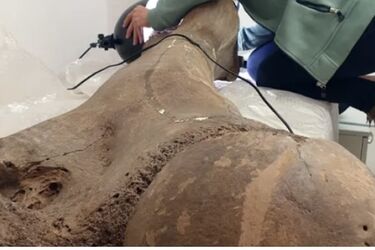Archaeologists discover 125,000-year-old straight-tusked elephants in Germany that were three times larger than modern ones

New research has shown that Neanderthals had the ability to form larger groups and hunt huge elephants that were three times the size of modern elephants. These conclusions were based on the study of the skeletal remains of straight-tusked forest elephants found in Germany near Halle.
This is reported by The Guardian.
The researchers found the bones of about 70 animals that lived about 125,000 years ago during the Pleistocene period. The findings were discovered in a large coal mine that has turned into an artificial lake in the 1980s.
The adults of these ancient animals were much larger than woolly mammoths and weighed up to 13 tons, which is three times the weight of modern Indian elephants.
One of the co-authors of the study, Wil Roebroeks, a professor of archaeology at Leiden University in the Netherlands, noted that hunting these giant animals was vital for the survival of Neanderthals in the area. This provided the first clear idea of how Neanderthals provided food for themselves, as well as the first unknown evidence of elephant hunting in human evolution.
The study also indicates that Neanderthals, who lived in the area for 2,000-4,000 years, formed social groups of much larger size than previously thought and were less mobile.
Based on the new research, it was found that ancient Neanderthals actively influenced their environment through the use of fire and had a significant impact on the largest animals that existed at the time.
The researchers concluded that Neanderthals hunted elephants, not just collected food scraps, which was confirmed by analyzing the age and sex of the bones found. It turned out that most of them belonged to males, usually young or old.
Scientists believe that this was a typical choice of hunters who hunted the largest prey.
It was easier for adult males to hunt than females, who usually moved in herds to protect their young. They spend most of their time alone, so it is easier to catch them by driving into a swamp or trap.
These huge elephants were an extremely high-calorie food that was common in these areas. Food from an elephant was enough for Neanderthals for several months.
Perhaps Neanderthals stored food for longer periods, which was not previously known, or they lived in much larger groups than previously thought.
Read also: Ancient stone penis with a "violent purpose" found in Spain (photo)
Scientists claim that Neanderthals hunted animals with flint tools that left clear marks on well-preserved bones. These marks are typical of cuts that occur when cutting and scraping meat from bones.
In addition, traces of fires, namely charcoal, were found. This may indicate that ancient people could dry meat by hanging it on racks and making a fire under them.
As a reminder, scientists found out that the Maya had a very high level of dentistry available even to the poor.
If you want to get the latest news about the war and events in Ukraine, subscribe to our Telegram channel!
